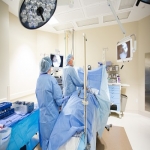People frequently wonder about the numerous medical terms that are used throughout the field of medicine. One of the most common ones in orthopedics is “scope.” That one simple abbreviated word can have numerous meanings. Most commonly in orthopedics, we are referring to arthroscopy. So what’s the difference between arthroscopy and laparoscopy?
Scope Similarities

They are minimally invasive diagnostic procedures. The scope is lense that you put in a small tube. It is attached to a camera that is placed in the body part that needs to be visualized. The first scopes were rigid tubes. The first was developed in 1806 by Philipp Bozzini in Mainz with his introduction of a “Lichtleiter” (light conductor) “for the examinations of the canals and cavities of the human body” (Daglilar, Kadayifci, and Brugge, 2016).
Later flexible scopes were introduced which allowed for deeper penetration into the body cavity of interest, and the ability to navigate around structures that would block a rigid scope.
Scope Differences

Scopes are named for the area of application. Hence, an arthroscope is used for joints (arthron is Greek for joint). A laparoscopy is used for evaluation of the abdominal contents (Greek lapára means flank or “soft spot”).
Similarly, there’s lots of different scopes: cystoscope (bladder); hysteroscope (uterus), rhinoscope (nose), endoscope (the gut in general and more specifically, gastroscope, duodenoscope; etc.).
The critical components are a light source, an eyepiece (with magnifier and/or video link); the tube reflector system and the steering assembly (Engelsgjerd and Deibert, 2020).
All kinds of instruments have been invented that can be used with the scope to perform procedures such as biopsy; cutting, coagulating, stapling etc (Engelsgjerd and Deibert, 2020).

Both procedure types are generally done with anesthesia and a small cut is made in the skin to insert the scope.
The physicians who perform the procedures are trained in their relevant disciplines.
Orthopedists in general do almost all arthroscopy; general surgeons do the laparoscopies for abdominal problems and gynecologists use them for female pelvic pathology; ENT physicians use them for the ear, nose and throat and urologists use them for the urinary system.
CO2 gas is injected to spread out the abdominal contents for laparoscopies, irrigation fluid is used in most joint procedures.
Now that you know the difference between the types of “scope” procedures, you can impress your care providers in all specialties.
Now that you know the difference between the types of “scope” procedures, you can impress your care providers in all specialties.
Written by: Trevor Yakle, ARNP
Sources:
Daglilar, E. S., Kadayifci, A., & Brugge, W. R. (2016). Upper Gastrointestinal Endoscopy. Yamada’s Atlas of Gastroenterology, 603-620.
Engelsgjerd, J. S., & Deibert, C. M. (2020). Cystoscopy. In StatPearls [Internet]. StatPearls Publishing.


